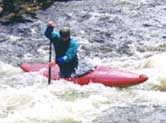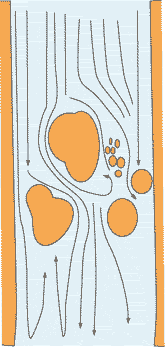 |
 |
||||||||||||||
 |
|||||||||||||||
Attainment Move A move used to go up current in a rapid. It is made with a variety of techniques using current to you advantage and your paddling effort to move up current on whitewater so that your ending point is visibly higher than your starting point.
Boof To bounce off rocks in the process of paddling. Sometimes done on purpose.
Broadwater Refers to wide stretches of water such as lakes, bays and the ocean. Wind and waves are two dominant forces the paddler has to deal with on broad water. See Tidewater.
C-1 A decked canoe. Like the kayak, it's decked (and in fact, it looks a lot like one), but the C-1 paddler kneels with his butt on a foam block pedestal and uses a single-bladed paddle. The boat pictured at the right top of this page is a C-1.
C-2 A two-person decked canoe, typically used for whitewater slalom races. Requires a great deal of skill and coordination between the paddlers. Known to break up marriages and life-long friendships. They are a lot of fun to watch.
Canoe In general, any boat that is propelled using single bladed paddles. Not necessarily an open boat, see C-1 and C-2. In Europe, what we call an open canoe is called a "Canadian;" while all decked canoes and kayaks are lumped together and called "canoes," often spelled with an initial "k." Also called C-boats.
Carabiner A device adopted from rock climbing. It is a strong metal loop with a gate that allows the insertion of a line or another carabineer. Very useful on the river. Available from places that sell climbing supplies and from most whitewater equipment suppliers.
CFS Cubic feet per second, a measure of river flow.
Chine See Hull Design
Class rating of rivers. What follows is a simplified version of the current river rating system. It applies specifically to individual rapids. The ratings we give to trips are a broad indication of the skill and equipment level needed. Weather and remoteness may add to the degree of difficulty.
...For example, the river has one class 4 drop that you portage. All the rest are class 2. The run is thus class 2. If the river has several class 3 drops not portaged, but most rapids are class 1 or 2, the trip is rated class 3. The same trip done with the air temperature below freezing might rate as a class 4 trip.
...River ratings are based on your ability to control a boat in a rapid. Just because you washed through one class 3 rapid doesn't rate you as a class 3 paddler.
...For more information, see www.americanwhitewater.org
Class I Fast moving water with riffles and small waves. Few obstructions, all obvious and easily missed with little training. Risk to swimmers is slight; self-rescue is easy. Local examples: All flatwater; most of the Delaware. Waves may be up to a foot high.
Class II Straightforward rapids with wide, clear channels which are evident without scouting. Occasional maneuvering may be required, but rocks and medium sized waves are easily missed by trained paddlers. Swimmers are seldom injured and group assistance, while helpful, is seldom needed. Local examples: The Delaware below the Lamberville Wing Dam (Summer levels); the Lehigh, White Haven to Jim Thorpe at summer release levels (under 800 cfs). Waves up to three foot high.
Class III Rapids with moderate, irregular waves which may be difficult to avoid and which can swamp an open canoe. Complex maneuvers in fast current and good boat control in tight passages or around ledges are often required; large waves or strainers may be present but are easily avoided. Strong eddies and powerful current effects can be found, particularly on large-volume rivers. Scouting is advisable for inexperienced parties. Injuries while swimming are rare; self-rescue is usually easy but group assistance may be required to avoid long swims. Local examples: The larger drops on the Tohichon at release level (600 cfs, 1.6 ft.); bigger drops on the Lehigh above 1,500 cfs.
Cass IV Intense, powerful but predictable rapids requiring precise boat handling in turbulent water. Depending on the character of the river, it may feature large, unavoidable waves and holes or constricted passages demanding fast maneuvers under pressure. A fast, reliable eddy turn may be needed to initiate maneuvers, scout rapids, or rest. Rapids may require "must'' moves above dangerous hazards. Scouting may be necessary the first time down. Risk of injury to swimmers is moderate to high, and water conditions may make self-rescue difficult. Group assistance for rescue is often essential but requires practiced skills. A strong Eskimo roll is highly recommended for decked boaters. Local examples: Black Creek into the Lehigh at high water; the Tohickon above 3,000 cfs.
Class V expert. Extremely long, obstructed, or very violent rapids which expose a paddler to added risk. Drops may contain large, unavoidable waves and holes or steep, congested chutes with complex, demanding routes. Rapids may continue for long distances between pools, demanding a high level of fitness. What eddies exist may be small, turbulent, or difficult to reach. At the high end of the scale, several of these factors may be combined. Scouting is recommended but may be difficult. Swims are dangerous, and rescue is often difficult even for experts. A very reliable Eskimo roll, proper equipment, extensive experience, and practiced rescue skills are essential.
Cass VI extreme and exploratory. These runs have almost never been attempted and often exemplify the extremes of difficulty, unpredictability and danger. The consequences of errors are very severe and rescue may be impossible. For teams of experts only, at favorable water levels, after close personal inspection and taking all precautions.
Cross-stroke What canoeists do when they need to take a paddle stroke on the other side of their boat.
Current The flow of water. Current generally moves down river, but does not necessarily (or even usually) move parallel with the river banks. Nor does it flow in a uniform direction nor at a uniform rate across the width of a river. Nor does it always flow parallel with the river bottom.
...Current, in local sections of a river, may flow at any angle to the banks. It frequently flows directly up river. (For example, in an eddy.) Water may flow straight down when it drops over a ledge. It may flow straight up when it abruptly meets and obstruction. Observe the current in even the smallest trickle of a stream and you can see all these flows.
...Current is not only produced by the flow of water down river. Tides and winds can produce strong and tricky currents that can baffle and endanger the paddler. Moving water, whether whitewater or tidewater, can exert a powerful force that demands due respect.

courtesy Millbrook Boats

courtesy rei.com


